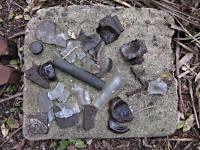Tosohatchee was not immune to the problem of the Texas Fever Tick epidemic that plagued much of the southeast from the early 1900s to the late 1930s. One of the methods for eradicating the tick was to run all the cattle through a dipping vat full of arsenic solution every two weeks. The vats were typically 25 to 30 feet long, 2.5 to 3 feet wide and 7 feet deep and made out of concrete. An artesian well was usually located nearby to facilitate the filling of the vat.
Tosohatchee has four vats that I'm aware of. One is located behind the ruins of the old barn at the Beehead Ranch complex near coordinates N28º 29.588 W80º 56.362. Interestingly enough there are some brand marks engraved on the ramp. One of the marks bares the resemblance of Two Fours which was used by Carl E. Barber during the 1930s. The large "13" was used be Annie Mathers. Gaston Jacobs supposedly used the "H" brand.1
The second vat is located in the corral at the Beehead Ranch complex near coordinates N28º 29.440 W80º 56.395.
The third one is located south of SR 520 near coordinates N28º 22.229 W80º 54.394. It has a lot of old bottle that could have been used to store the arsenic solution. There's also a bath tub with an artesian well right next to it. I always thought that was how the old timers took their baths, but as it turns out, the tub was more for the cows than anything else.
The forth one is located south of Power Line Road along the St. Johns River at coordinates N28 º 29.392 W80º 52.954. Only a small portion of the vat can been seen today. It appears a bulldozer might have leveled the top of the vat and backfilled the hole at some early date. Lots of broken glass, pieces of iron and a well head can also be found in the area. This place might also be the site of Streetman's Cabin.
According to a list of known dipping vats from Florida Department of Environment Protection, there was one vat built in 1931 at the "Game Reserve". I suspect that was the one that had the brand marks. The other two could be Tosohatchee Ranch Co. #1 & #2 built in 1916 but they are registered in Seminole County for some reason.
Note: Use caution when visiting these areas. Arsenic is toxic and can linger in the soil and water for many years.










